|
| |
- Coenagrionidae is the most abundant damselfly in Brisbane area. They are usually with
black pattern, the ground colour may be green, blue, yellow, orange, or
purple. Their wings are narrow, usually colourless and clear. Some species are two female colour forms,
i.e., one of which is similar to
the male while the other is very different.
-
 -
- They prefer to lay eggs in pond, slow or fast
running waters with dense vegetations. They rest with the body horizontal and the wings pressed
together above the abdomen. The adult is a predator in the sky and
preying on small flying insects such as mosquitoes.
-
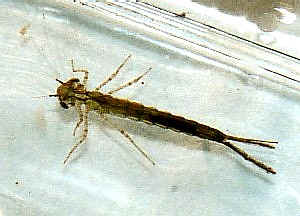 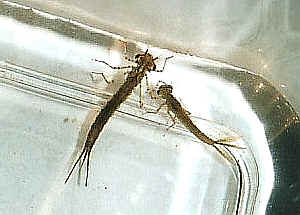 - Larva 20mm
-
- The larva is a predator in water preying on
small animals such as mosquitoes larva. The larva uses its tail. the three
leaf, to breath in water. Just before the last
molting, the larva climb up from the water and emerge from the last
molting skin and turns into an adult.
-
- In this family, we found quite a number of different species in Brisbane.
They are slender, with small to medium body size. The smallest damselflies are also found in
this family.
-
-
- Gold-fronted Riverdamsel, Gold-fronted Sprite

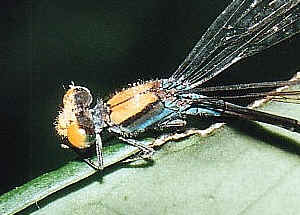 - Pseudagrion aureofrons, male, body length 36mm
- Gold-fronted Riverdamsels can be found on slow running water or still water.
Males can be easily recognized by their golden-yellow faces.
Their lower part of
thorax are blue, with black colour in between. Their abdomen are black, with
blue ring at tail. females are dull greenish grey in colour. More information please click
on here.
-
-
- Blue Riverdamsel, Blue Sprite Damselfly

 - Pseudagrion microcephalum, male, female, body length 38mm
- The male damselfly is brightly blue in colour with black pattern on
abdomen. Its blue head, its face and eyes are blue too. The female damselfly has the
pale blue-grey abdomen and yellowish-green thorax and eyes.
We took those pictures at Wishart
along Bulimba Creek. For more detail see our Blue
Riverdamsel page.
-
-
- Flame-headed Riverdamsel, Flame-headed Sprite
Damselfly
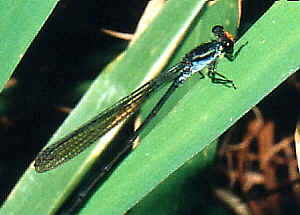
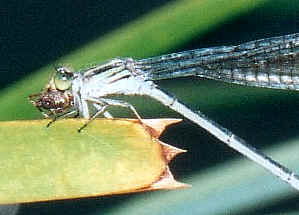 - Pseudagrion ignifer, male, female, body length 46mm
- This is a large Damselfly. Males are easily recognized by their orange-yellow faces.
The second picture shows the female Flame-headed Riverdamsel, she is enjoying a meal. More information please click here.
-
-
- Redtail, Big Red Damselfly
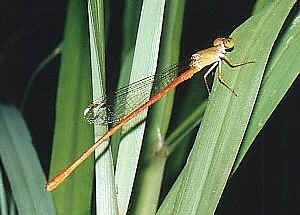
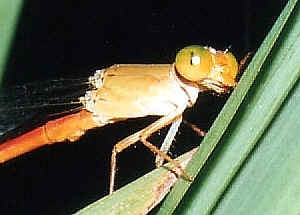 - Ceriagrion aeruginosum, body length 40mm
- The Redtail Damselflies are beautiful with orange-red abdomen, yellow-green thorax and yellow-green head. Although they are
bright in colour, they are not
easily be seen. They usually hiding among the thick grass near the waters. We
occasionally find them along Moolabin Creek in Brisbane. More information please click here.
-
-
- Red and Blue Damselfly
 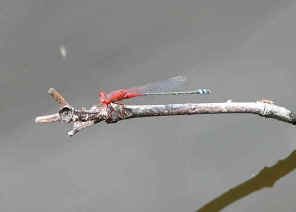 - Xanthagrion erythroneurum, body length 40mm
- The Red and Blue Damselflies are with bright red face and thorax. Their
abdomen is pale colour, with blue marking at tail. Red and Blue Damselfly
larvae live in still water. We found the Red and Blue Damselflies along the
water edge near the lake inside Minnippi Park, Tingalpa, where is the end of
Bulimba Creek, about to meet the Brisbane River.
-
-
- Eastern Billabongfly, Eastern Dart

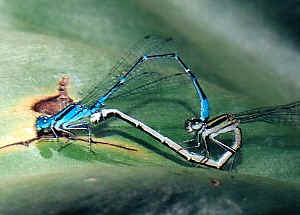 - Austroagrion watsoni , male, male and female, body length 25mm
- Eastern Billabongflies are small damselflies.
They can be found near slow running water or still water. They usually rest on
the plants either in the middle of ponds or at the water edges. More information please click here.
-
-
- Aurora Bluetail Damselfly
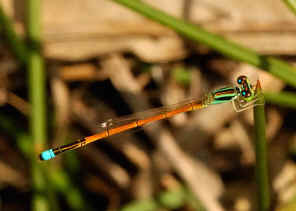
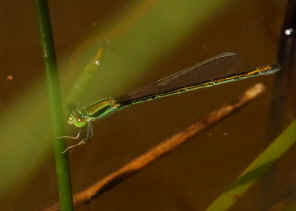 - Ischnura aurora, male, female, body length 23mm
- Aurora Bluetail
Damselflies are tiny damselflies. Males are beautifully
have the colour of the rainbow. The head and thorax are from green to
yellow, the abdomen is from yellow to orange to red. There is the bright
blue at the tip. The back of the thorax is black. The females are pale grey
in colour. Click here for more
information.
-
-
- Common Bluetail Damselfly

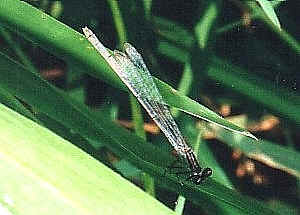 - Ischnura heterosticta, male, female,
body length 34mm
- Common Bluetail
Damselflies are one of the most common damselflies found in Brisbane waters.
They can easily be found near running water or still water, however, they are
easily mistaken as Blue Riverdamsel. Common Bluetail
Damselflies are smaller, with more black than blue on their back. There is the blue tip at the end of abdomen.
They usually rest on
the plants either in the middle of ponds or at the water edges. More information please click here.
-
-
- Red-tipped Shadefly
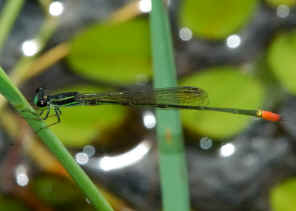
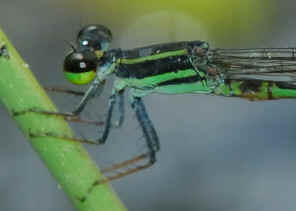 - Argiocnemis rubescens, male, immature male, body length 35mm
- We found this damselfly once in the Lagoon in Karawatha Forest Feb 2008.
We sometimes confused this damselfly with the Red-rumped Wisp.
They looked almost the same. To find out the details
please check this page.
-
-
- Pygmy Wisp, Midget Wisp
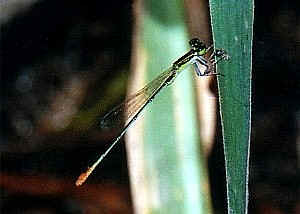

- Agriocnemis pygmaea, male body length 20mm, female 25mm
- The Midget Whisp is
the smallest damselflies we had ever found. The head and thorax is pale green in
colour with black pattern. Abdomen is pale red with black with the red tail
light. More information on Pygmy Wisp
page.
-
- Red-rumped Wisp
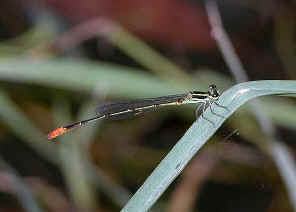 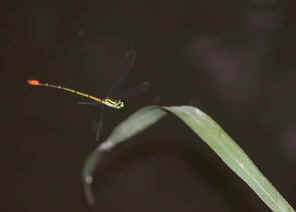 - Agriocnemis rubricauda, male, body length 30mm
- The damselfly has the very bright orange-red tail. Its body is pale green
and black in colour. We only saw this damselfly once along Bulimba Creek in Yugarapul
Park. We
took the photos late in the evening, while the sunlight was about to
ease. The damselfly's tail of bright orange spot was outstanding from the dark
surroundings. More pictures and information please visit this page.
-
-
- Reference:
- 1. The Australian Dragonflies - CSIRO, Watson, Theisinger & Abbey,1991,
p120.
- 2. The Complete Field Guide to Dragonflies of Australia - CSIRO, GŁnther Theischinger and John Hawking, 2006,
p82.
Back to Top
| |
|

























